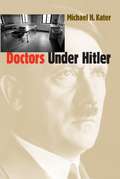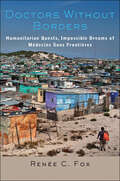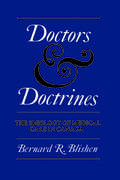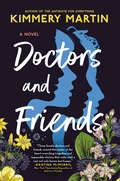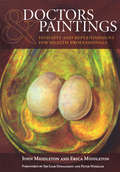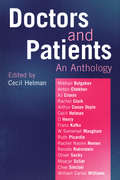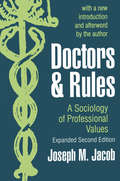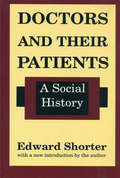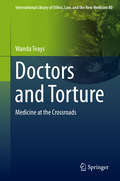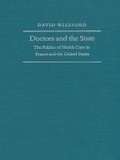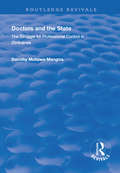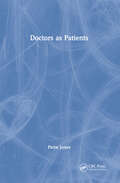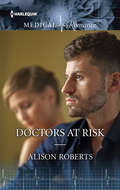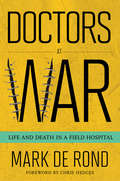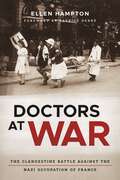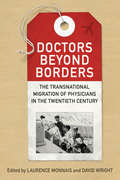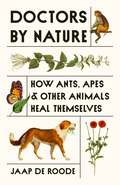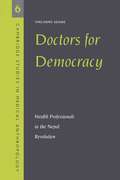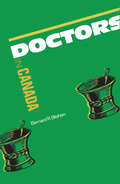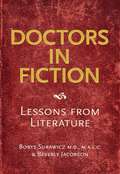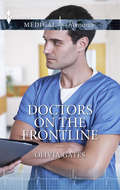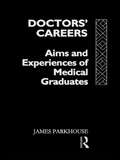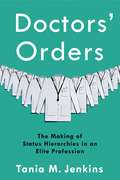- Table View
- List View
Doctors Under Hitler
by Michael H. Kater"A brilliant attempt to explain the profound historical crisis into which medicine had plummeted during the Nazi period with the tried methods of social history.--Historische Zeitschrift"The author has drawn from an extraordinary range of sources, and the weight of evidence he compiles will certainly give pause to anyone who still wants to believe that professionals kept their hands clean in this era of great and methodical crimes.--Journal of Modern History"Kater's important book deserves close attention from historians of medicine and German historians alike.--IsisIn this history of medicine and the medical profession in the Third Reich, Michael Kater examines the career patterns, educational training, professional organization, and political socialization of German physicians under Hitler. His discussion ranges widely, from doctors who participated in Nazi atrocities, to those who actively resisted the regime's perversion of healing, to the vast majority whose ideology and behavior fell somewhere between the two extremes. He also takes a chilling look at the post-Hitler medical establishment's problematic relationship to the Nazi past. -->
Doctors Without Borders: Humanitarian Quests, Impossible Dreams of Médecins Sans Frontières
by Renée C. FoxAn intimate portrait of the renowned international humanitarian organization.Winner of the PROSE Award for Excellence, Sociology and Social Work of the Association of American PublishersThis study of Médecins Sans Frontières / Doctors Without Borders (MSF) casts new light on the organization’s founding principles, distinctive culture, and inner struggles to realize more fully its "without borders" transnational vision.Pioneering medical sociologist Renée C. Fox spent nearly twenty years conducting extensive ethnographic research within MSF, a private international medical humanitarian organization that was created in 1971 and awarded the Nobel Prize for Peace in 1999. With unprecedented access, Fox attended MSF meetings and observed doctors and other workers in the field. She interviewed MSF members and participants and analyzed the content of such documents as communications between MSF staff members within the offices of its various headquarters, communications between headquarters and the field, and transcripts of internal group discussions and meetings. Fox weaves these threads of information into a rich tapestry of the MSF experience that reveals the dual perspectives of an insider and an observer. The book begins with moving, detailed accounts from the blogs of women and men working for MSF in the field. From there, Fox chronicles the organization’s early history and development, paying special attention to its struggles during the first decades of its existence to clarify and implement its principles. The core of the book is centered on her observations in the field of MSF’s efforts to combat a rampant epidemic of HIV/AIDS in postapartheid South Africa and the organization’s response to two challenges in postsocialist Russia: an enormous surge in homelessness on the streets of Moscow and a massive epidemic of tuberculosis in the penal colonies of Siberia. Fox’s accounts of these crises exemplify MSF’s struggles to provide for thousands of people in need when both the populations and the aid workers are in danger.Enriched by vivid photographs of MSF operations and by ironic, self-critical cartoons drawn by a member of the Communications Department of MSF France, Doctors Without Borders highlights the bold mission of the renowned international humanitarian organization even as it demonstrates the intrinsic dilemmas of humanitarian action.
Doctors and Doctrines: The Ideology of Medical Care in Canada
by Bernard BlishenThere has been controversy for several years now in Canada over the various developments in insurance for medical care. The Canadian Medical Association is of course concerned with protecting the profession as well as the public: those who believe in a government-sponsored medicare plan claim that the medical profession's reaction is based on self-interest. The debate was intensified by the 1962 medicare dispute in Saskatchewan, the publication in 1964 of the first two volumes of the Report of the Royal Commission on Health Services, and the more recent disagreement between the federal and provincial governments over the issue. Professor Blishen here examines the position of the medical profession in this debate as part of an ideological reaction to a rapidly changing society. The growth of scientific knowledge, demographic change, and shifting social values all have an impact on the medical profession: the doctors' dilemma must be seen against this background.The focus of this analysis throughout is the physician's role: the examples are Canadian but the ideologies and situations involved are relevant to all countries with a similar medical development.
Doctors and Friends
by Kimmery Martin&“Three female doctors and friends remind the reader of the heart-wrenching tragedies and impossible choices that make such a cast not only heroic but human.&”—Kristina McMorris, New York Times bestselling author of Sold on a Monday Hannah, Compton, and Kira have been close friends since medical school, reuniting once a year for a much-needed vacation. Just as they gather to travel in Spain, an outbreak of a fast-spreading virus throws the world into chaos. When Compton Winfield returns to her job as an ER doctor in New York City, she finds a city changed beyond recognition—and a personal loss so gutting it reshapes every aspect of her life. Hannah Geier&’s career as an ob-gyn in San Diego is fulfilling but she&’s always longed for a child of her own. After years of trying, Hannah discovers she's expecting a baby just as the disease engulfs her city. Kira Marchand, an infectious disease doctor at the CDC in Atlanta, finds herself at the center of the American response to the terrifying new illness. Her professional battle turns personal when she must decide whether her children will receive an experimental but potentially life-saving treatment. Written prior to Covid-19 by a former emergency medicine physician, Doctors and Friends incorporates unexpected wit, razor-edged poignancy, and a deeply relatable cast of characters who provoke both laughter and tears. Martin provides a unique insider&’s perspective into the world of medical professionals working to save lives during the most difficult situations of their careers.
Doctors and Paintings: A Practical Guide, v. 1
by John Middleton Erica MiddletonThis work includes forewords by Sir Liam Donaldson and Peter Wheeler, Chief Medical Officer, Department of Health; Dean, College of Fine Arts, University of Sharjah, United Arab Emirates. Appreciating art can help doctors build empathy with patients and reduce stress. By stimulating thought and reflection through paintings, this concise and engaging text invites readers to examine their motivation, their profession and their world. This exciting new book provides vital refreshment for doctors and medical students, lecturers and tutors in medical humanities, and healthcare professionals with mentoring roles. "John and Erica Middleton guide the reader gently along the interface between art and medicine, in their own inimitable style. Whether in search of an introduction to the world of art, or wishing to consider the role that the formal study of art might play in professional development, reading this book is likely to prove rewarding. Turning these pages will help doctors to appreciate afresh the window through which they look upon the world" - Sir Liam Donaldson, in his Foreword. "Great art provides insights into the human condition. If through a systematic engagement with art and literature as an extension of their medical practice, GPs can apply those insights to themselves (know thyself), they can equally apply them when dealing with patients. Doctors and patients are people, subjects. Intersubjectivity is perhaps a better word than empathy to define what this book seeks to promote, the capacity of the doctor to enter into and inhabit the patient's subjectivity" - Peter Wheeler, in his Foreword.
Doctors and Patients - An Anthology
by Cecil HelmanThis is a wonderful collection of stories about doctors and patients, including many by world-famous authors who were also physicians, such as Oliver Sacks, Anton Chekhov and Arthur Conan Doyle. Always moving, entertaining and informative, and sometimes troubling, these remarkable stories will appeal to anyone with an interest in health, illness and medical care. They also provide essential core material for those studying doctor-patient communication, the literature of medicine and medical humanities. The stories, some written from the doctor's viewpoint, some from that of the patient, illuminate the warmth and compassion - but also the many problems - in relationships between doctors and patients, both in the past and today. Doctors and Patients: an anthology is enjoyable, fascinating and enlightening - for oneself, and for friends and partners, whether healthcare professionals or interested general readers.
Doctors and Rules: A Sociology of Professional Values
by Joseph M. JacobDoctors and Rules is a unique and immensely scholarly book. It draws on material which has informed our civilization, including many of the social sciences-history, sociology, and psychology, as well as law. The author accesses the current importance of the Hippocratic tradition within medicine, and puts forward various models of its practice. He seeks to expose the often inarticulated foundation of contemporary debates about the law, medicine, and health, and to question some common assumptions of the functionsand structures of social and legal order. The book challenges the idea that legal rules should be respected merely because they exist and because they play a part in centralizing the organization of society. It rejects the notion that the courts always, or even often, offer useful mechanisms for defining and settling disputes. On the contrary, the author sees in their formalism many things which hinder the common cause of humanity. Only a skeptic trained in law but also deeply concerned by our fate and circumstances could have produced it. It also contributes both to the sociology of law and the sociology of medicine. Out of a reassertion of old ways, this book presents a new blueprint for future professional conduct. It is rich in questions and ideas for researchers, teachers, and professionals in the fields of law, medical sociology, and medicine and generally for those concerned with the place of professional conduct.
Doctors and Their Patients: A Social History
by Edward ShorterWith every passing year, the mutual mistrust between doctor and patient widens, as doctors retreat into resentment and patients become increasingly disillusioned with the quality of care. Rich in anecdote as well as science 'Doctors and Their Patients' describes how both have arrived at this sad shape.
Doctors and Torture: Medicine at the Crossroads (International Library of Ethics, Law, and the New Medicine #80)
by Wanda TeaysThis book brings into sharp relief the extent to which the medical profession has enabled or participated in actions that are at moral crossroads. Physical and psychological abuse and violations of medical codes have already been brought to light by concerned bioethicists responding to ethical lapses of the “war on terror.” This book goes to the next level by looking at three areas that also merit our attention and call us to speak out against abuses. These are (1) dehumanization (such as forced nudity, hooding, sensory deprivation, exploitation of phobias, waterboarding, and environmental manipulation), (2) non-consensual forced-feeding, and (3) solitary confinement. Each area raises important questions for the medical profession.Author Wanda Teays calls upon doctors and nurses to reflect on the role they play in the unethical treatment of prisoners and detainees by crossing moral boundaries around each of these areas. In the process, we are reminded that bioethics is global, not local — and the concerns of the discipline encompass issues with a wider scope.
Doctors and the State: The Politics of Health Care in France and the United States
by David WilsfordAll advanced health care systems face severe difficulties in financing the delivery of today's sophisticated medical care. In this study David Wilsford compares the health systems in France and the United States to demonstrate that some political systems are considerably more effective at controlling the cost of care than others. He argues that two variables--the autonomy of the state and the strength and cohesiveness of organized medicine--explain this variance.In France, Wilsford shows, the state is strong in the health policy domain, while organized medicine is weak and divided. Consequently, physicians exercise little influence over health care policymaking. By contrast, in the United States the state is weak, the employers and insurers who pay for health care are fragmented, and organized medicine is strong and well financed. As a result, medical professionals are able to exert a greater influence on policymaking, thus making cost control more difficult.Wilsford extends his comparison to health care systems in the United Kingdom, West Germany, Italy, Canada, and Japan. Whether the private or public sector finances health care, he discovers, there is now an important trend in all of the advanced industrial countries toward controlling escalating costs by curbing both the medical profession's clinical autonomy and physicians' incomes.
Doctors and the State: The Struggle for Professional Control in Zimbabwe (Routledge Revivals)
by Dorothy Mutizwa-MangizaPublished in 1999, the main aim of this text is to examine the nature of professional control, medical practice and the state of health services in a post-colonial state and the medical profession in Zimbabwe since 1980. The text reviews the theories of professions and professional control and medical practice, it concludes by examining the nature of the Zimbabwean state. The chapter on methodology highlights some of the ethical dilemmas of carrying out research in developing countries. The book then goes on to review health services and policies of both the colonial and post-colonial governments in Zimbabwe. Three chapters discuss the nature of medical practice and the constraints encountered by doctors in their work, the terms and conditions of service under which doctors work, and the nature of medical regulation of education, licensing and discipline including issues such as malpractice and litigation. Throughout the book, comparisons are made with situations in other countries, both developed and developing, and the main conclusions of the book are that medical doctors in Zimbabwe have minimal administrative restrictions on the type of treatment which they can carry out but the unavailability and breakdown of essential equipment, shortages of essential drugs and staff limit the doctors' autonomy to carry out the treatment that they consider necessary.
Doctors as Patients
by Petra JonesDoctors, as strong, clever, resourceful professionals, are heir to human frailty and illness, like anyone else. This book is about diagnosable, label-able mental illness such as eating disorders, affective disorders and, sometimes, psychosis. More than that, it is a book about doctors, many fully-functioning, practising doctors, who suffer from these illnesses, and the unique insights and problems that arise when the doctor is the patient, especially when questions of insight and judgement are blurred.
Doctors at Risk
by Alison RobertsAn injured doctor...and his determined nurse! Dr. Ross Turnball and nurse Wendy Watson fell in love on an Urban Search and Rescue course. It ended explosively, with a dramatic mission to rescue people from a bombed shopping mall--and an accident that nearly claimed Ross's life. Now Ross struggles to regain his health--and he's terrified he'll lose Wendy's love. Wendy knows that as long as she's with Ross nothing else matters. But can she persuade him of that?
Doctors at War: Life and Death in a Field Hospital (The Culture and Politics of Health Care Work)
by Mark de RondDoctors at War is a candid account of a trauma surgical team based, for a tour of duty, at a field hospital in Helmand, Afghanistan. Mark de Rond tells of the highs and lows of surgical life in hard-hitting detail, bringing to life a morally ambiguous world in which good people face impossible choices and in which routines designed to normalize experience have the unintended effect of highlighting war’s absurdity. With stories that are at once comical and tragic, de Rond captures the surreal experience of being a doctor at war. He lifts the cover on a world rarely ever seen, let alone written about, and provides a poignant counterpoint to the archetypical, adrenaline-packed, macho tale of what it is like to go to war. Here the crude and visceral coexist with the tender and affectionate. The author tells of well-meaning soldiers at hospital reception, there to deliver a pair of legs in the belief that these can be reattached to their comrade, now in mid-surgery; of midsummer Christmas parties and pancake breakfasts and late-night sauna sessions; of interpersonal rivalries and banter; of caring too little or too much; of tenderness and compassion fatigue; of hell and redemption; of heroism and of playing God. While many good firsthand accounts of war by frontline soldiers exist, this is one of the first books ever to bring to life the experience of the surgical teams tasked with mending what war destroys.
Doctors at War: The Clandestine Battle against the Nazi Occupation of France
by Ellen HamptonDoctors at War tells the stories of physicians in France working to impede the German war effort and undermine French collaborators during the Occupation from 1940 to 1945. Determined to defeat the Third Reich’s incursion, one group of prominent Paris doctors founded a medical network to treat injured Resistance fighters who they then secretly transported to Allied countries to avoid forced labor in Germany. Another team of medics organized a cabal focused on intelligence gathering and sabotage that became one of the largest in wartime France, even after the Gestapo arrested and imprisoned its leaders. Deported to concentration camps, these physicians continued to frustrate Nazi efforts by rendering aid and keeping their fellow prisoners alive. Others joined rural guerrilla camps to care for the young conscripts fighting to block German reinforcements from reaching Normandy after the D-Day landing.These stories, assembled here for the first time, add a crucial dimension to the history of Occupied France. Written for both historians and general readers of World War II history, Doctors at War stands as a dramatic, character-driven account of physicians’ courage and resilience in the face of evil. It serves as a window into life under a fascist regime and the travails of doctors who negotiated the terrifying moral labyrinth that was the German military’s occupation of France.
Doctors beyond Borders: The Transnational Migration of Physicians in the Twentieth Century
by David Wright Laurence MonnaisThe transnational migration of health care practitioners has become a critical issue in global health policy and ethics. Doctors beyond Borders provides an essential historical perspective on this international issue, showing how foreign-trained doctors have challenged - and transformed - health policy and medical practice in countries around the world.Drawing on a wide variety of sources, from immigration records and medical directories to oral histories, the contributors study topics ranging from the influence of South Asian doctors on geriatric medicine in the United Kingdom to the Swedish reaction to the arrival of Jewish physicians fleeing Nazi Germany and the impact of the Vietnam War on the migration of doctors to Canada. Combining social history, the history of health and medicine, and immigration history, Doctors beyond Borders is an impressive selection of essays on a topic that continues to have global relevance.
Doctors by Nature: How Ants, Apes, and Other Animals Heal Themselves
by Jaap de RoodeThe astonishing story of how animals use medicine and what it can teach us about healing ourselvesAges before the dawn of modern medicine, wild animals were harnessing the power of nature&’s pharmacy to heal themselves. Doctors by Nature reveals what researchers are now learning about the medical wonders of the animal world. In this visionary book, Jaap de Roode argues that we have underestimated the healing potential of nature for too long and shows how the study of self-medicating animals could impact the practice of human medicine.Drawing on illuminating interviews with leading scientists from around the globe as well as his own pioneering research on monarch butterflies, de Roode demonstrates how animals of all kinds—from ants to apes, from bees to bears, and from cats to caterpillars—use various forms of medicine to treat their own ailments and those of their relatives. We meet apes that swallow leaves to dislodge worms, sparrows that use cigarette butts to repel parasites, and bees that incorporate sticky resin into their hives to combat pathogens. De Roode asks whether these astonishing behaviors are learned or innate and explains why, now more than ever, we need to apply the lessons from medicating animals—it can pave the way for healthier livestock, more sustainable habitats for wild pollinators, and a host of other benefits.Doctors by Nature takes readers into a realm often thought to be the exclusive domain of humans, exploring how scientists are turning to the medical knowledge of the animal kingdom to improve agriculture, create better lives for our pets, and develop new pharmaceutical drugs.
Doctors for Democracy: Health Professionals in the Nepal Revolution
by Vincanne AdamsThis book examines the role of the Nepali physicians in the revolutionary changes in 1990. These doctors are trained in the Western tradition, and participate in international scientific debates, yet they have always been concerned to develop a form of medical practice that was relevant to Nepali conditions, and which could speak to local conceptions about health, and so their medical practice was always politicized. Vincanne Adams argues that the commitment of these professionals to the values of science, and to public health, was crucial in their political activity, and that ideas and practices associated with the notions of 'democracy' and of 'science' supported each other. Describing her book as 'a story that explores how very fine the line is between politics and scientific medical truth claims', it therefore encompasses both the modern political history of Nepal and the role of medicine in a poor, largely rural, Hindu kingdom.
Doctors in Canada
by Bernard BlishenThrough the twentieth century, the nature of medical practice has changed more quickly, more dramatically, and far more publicly than that of any other profession in Canada. In this study Bernard Blishen identifies the social and political pressures on the medical profession and assesses how it has responded to them.Among the changes doctors have confronted are third-party pressures from government and hospital bureaucracies, greater public knowledge, improved technology, recognition of patients' rights, and legal challenges. Blishen discusses how the doctors achieved dominance in the health field, reviews demographic changes within the profession and the larger population, examines data on the changing health status of Canadians, and charts physician supply against patient demand. He finds that the chief source of his profession's collegial strength has been the homogeneity of its membership. This homogeneity is declining with increasing numbers of women and ethnic groups in the profession and increasing specialization.Blishen offers a comprehensive, quantified overview of a profession in transition, and suggests the implications of its changes for all Canadians.
Doctors in Fiction: Lessons from Literature (Radcliffe Ser.)
by Beverly Jacobson Borys SurawiczMedical practitioners are key actors in many well-known works of fiction and literature, presenting a vital insight into the social, medical, scientific and ethical concerns of their authors and readers. However, medical professionals are often left little time to explore such cultural perceptions of their profession, and by extension themselves, despite the extent to which the views of their patients and society have been - and still are - shaped by them. Doctors in Fiction explores and analyzes representations of medical practitioners in fiction, encompassing classic and contemporary literature, popular fiction, and authors from many nations and traditions. These include among others: Albert Camus A* Anton Checkhov A* Robertson Davies A* Graham Greene A* George Eliot A* Ian McEwan A* F. Scott Fitzgerald A* Jaroroslav Hasek A* Henrik Ibsen A* John Irving A* Patrick O'Brien A* Boris Pasternak A* Aleksandr Solzhenitsyn This book will be of interest to those with an interest in the medical humanities, and to students of cultural history and literature. It will also be of particular interest to medical practitioners of all kinds who enjoy literature and wish to understand and reflect upon wider perceptions of their profession.
Doctors in Flight
by Meredith WebberCity girl goes bush! Dr. Hillary Green never wanted to work in the Outback. But now she's been appointed to the Flying Obs and Gynae service, taking tiny planes to little rural hospitals, along with an airsick anesthetist and a boss who hates women registrars! Well, Hillary doesn't like him, either. Even if he is a terrific doctor…and even if his touch sends needles of excitement shooting up her arm….
Doctors of Empire
by Hoi-Eun KimThe history of German medicine has undergone intense scrutiny because of its indelible connection to Nazi crimes. What is less well known is that Meiji Japan adopted German medicine as its official model in 1869. In Doctors of Empire, Hoi-eun Kim recounts the story of the almost 1,200 Japanese medical students who rushed to German universities to learn cutting-edge knowledge from the world leaders in medicine, and of the dozen German physicians who were invited to Japan to transform the country's medical institutions and education.Shifting fluently between German, English, and Japanese sources, Kim's book uses the colourful lives of these men to examine the impact of German medicine in Japan from its arrival to the pinnacle of its influence and its abrupt but temporary collapse at the outbreak of the First World War.Transnational history at its finest, Doctors of Empire not only illuminates the German origins of modern medical science in Japan but also reinterprets the nature of German imperialism in East Asia.
Doctors on the Frontline
by Olivia GatesDoctors in danger... Dr. Sherazad Dawson joined the Global Aid Organization's medical team in a war-torn state to escape her past. She never expected to find her future there! Amid the urgency of frontline medicine, an irresistible Italian doctor, Lorenzo Banducci, becomes Sherazad's boss, friend--and lover. Lorenzo spends his life helping casualties. He won't leave the frontline, but he fears the risks to Sherazad if she stays. Can she persuade the dedicated doctor that the greatest danger would be losing him?
Doctors' Careers: Aims and Experiences of Medical Graduates
by James ParkhouseFirst published in 1991. Routledge is an imprint of Taylor & Francis, an informa company.
Doctors' Orders: The Making of Status Hierarchies in an Elite Profession
by Tania M. JenkinsThe United States does not have enough doctors. Every year since the 1950s, internationally trained and osteopathic medical graduates have been needed to fill residency positions because there are too few American-trained MDs. However, these international and osteopathic graduates have to significantly outperform their American MD counterparts to have the same likelihood of getting a residency position. And when they do, they often end up in lower-prestige training programs, while American-trained MDs tend to occupy elite training positions. Some programs are even fully segregated, accepting exclusively U.S. medical graduates or non-U.S. medical graduates, depending on the program’s prestige. How do international and osteopathic medical graduates end up so marginalized, and what allows U.S.-trained MDs to remain elite?Doctors’ Orders offers a groundbreaking examination of the construction and consequences of status distinctions between physicians before, during, and after residency training. Tania M. Jenkins spent years observing and interviewing American, international, and osteopathic medical residents in two hospitals to reveal the unspoken mechanisms that are taken for granted and that lead to hierarchies among supposed equals. She finds that the United States does not need formal policies to prioritize American-trained MDs. By relying on a system of informal beliefs and practices that equate status with merit and eclipse structural disadvantages, the profession convinces international and osteopathic graduates to participate in a system that subordinates them to American-trained MDs. Offering a rare ethnographic look at the inner workings of an elite profession, Doctors’ Orders sheds new light on the formation of informal status hierarchies and their significance for both doctors and patients.
